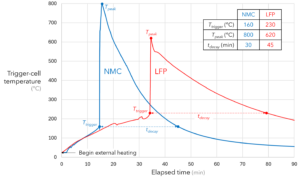Making batteries safer by understanding the important thing thermodynamic variations between the most well-liked cell chemistries
Whereas NMC cells dominate the present era of US and European BEVs, rising value pressures are forcing OEMs to take a more durable have a look at LFPs. Regardless of their decrease vitality density, LFP cells are nonetheless susceptible to single-cell thermal runaway, and controlling its propagation to adjoining cells stays a high precedence. To correctly handle thermal runaway propagation (TRP), pack designers should first perceive the three key thermodynamic variations between the 2 cell sorts.
First, NMC cells set off extra simply. The chart beneath exhibits two equally sized prismatic cells triggered into thermal runaway with an exterior heating pad. The NMC cell goes unstable at a temperature of 160°C, whereas the LFP holds regular as much as 230°C. This deeper thermal properly, mixed with LFPs’ larger measurement and weight for a similar vary, gives an LFP pack with extra thermal mass than its NMC counterpart. The thermal mass of adjoining cells is without doubt one of the few benign pathways that stray vitality can take throughout a runaway occasion (the opposite being rejection by way of the pack’s cooling system). Whereas cell-to-cell conduction by itself can’t soak up the complete brunt of a runaway occasion, thermal mass can present further time for occupants to tug over and get away from the automobile.
Second, NMC cells burn hotter than LFPs. As soon as pushed into thermal runaway, the NMC cell-face temperature peaks at 800°C, whereas the LFP solely spikes to 620°C. That is considerably paradoxical since, regardless of their decrease vitality density, calorimetry exhibits that LFP cells typically have the next gas content material per amp-hour of storage capability. Nevertheless, as a result of NMCs smuggle extra elemental oxygen into the cell, their combustion effectivity and, subsequently, warmth launch is greater.
Lastly, the ejection phenomena related to every cell chemistry are very totally different. When an NMC cell goes into thermal runaway, there tends to be a 10- to 30-second interval wherein liquid, gasoline, and strong supplies are violently ejected by way of the cell vent. These strong supplies are sometimes bits of aluminum, carbon, and burning plastic. So NMC cells deliver all three components of the hearth triangle – gas, oxygen, and an ignition supply – to a thermal runaway occasion. The ensuing torch-and-grit blast can burn by way of all however the sturdiest enclosure supplies and blankets the encircling cells in flaming gases and particles. Managing these flows is without doubt one of the most troublesome points of designing a TRP-resistant NMC pack.

In distinction, LFP cells are likely to emit principally smoke and gasoline which, though scorching, is often not actively combusting. Whereas subsequent combustion and even explosions are potential, the inside of an LFP pack is often oxygen-starved throughout a thermal runaway occasion, so these dangers exist primarily outdoors the automobile. Additional, the overall mass ejected from an LFP thermal runaway is just 20-25% of the unique cell mass, versus 40-50% for an NMC. So, each the hazard degree and amount of LFP ejecta are decrease than that of NMC designs.
Briefly, controlling thermal propagation in an NMC pack is primarily about gasoline administration and secondarily about direct cell-to-cell warmth switch. In an LFP pack, that dynamic is reversed. That is lucky: with the appearance of aerogel thermal boundaries comparable to PyroThin cell boundaries, cell-to-cell warmth switch is now a solved downside. Managing combustion gases and flaming ejecta stays stubbornly laborious to handle.
aerogel.com


